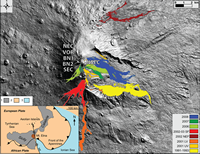Constraints on the Nature and Evolution of the Magma Plumbing System of Mt. Etna Volcano (1991–2008) from a Combined Thermodynamic and Kinetic Modelling of the Compositional Record of Minerals
Kahl, M., S. Chakraborty, M. Pompilio & F. Costa (2015).
Journal of Petrology, Oxford University Press 56, 2025–2068.
Abstract
Deciphering the evolution of the internal dynamics of magmatic plumbing systems and identifying the key parameters that drive such dynamics are major goals of modern volcanology. Here we present a novel petrological approach that combines kinetic modelling of the diffusive relaxation of chemical zoning patterns in olivine crystals with thermodynamic modelling (MELTS) to constrain the nature and evolution of the plumbing system of Mt. Etna and the processes governing its internal dynamics. We investigated the compositional and temporal record preserved in 180 olivine crystals that were erupted between 1991 and 2008. Detailed systemization of the information stored in the sequential zoning record of the olivines reveals the existence of at least five compositionally different magmatic environments (MEs), characterized by different olivine compositions: M0 (Fo79–83), M1 (Fo75–78), M2 (Fo70–72), M3 (Fo65–69) and mm1 (Fo73–75). Several routes of magma transfer connect these environments. We identified three prominent magma passageways between the environments M0:M1, M2:mm1 and M1:M2 that were active during the entire period of observation between 1991 and 2008. Modelling the diffusive relaxation of the olivine zoning patterns reveals that the transfer of magma along such routes can occur over fairly heterogeneous timescales ranging from days to 2 years. Although some of the passageways have been sporadically active in the months and sometimes years before an eruption, the magma migration activity increases clearly in the weeks and days prior to an eruptive event. In this context, major transfer routes such as M2:mm1 might represent temporary passageways that are activated only shortly before eruptive events. A forward modelling approach was developed using thermodynamic calculations with the MELTS software to identify the key intensive variables associated with the different magmatic environments. In this approach the observed populations of mineral compositions (e.g. Fo79–83), rather than single compositions, are associated with thermodynamic parameters [pressure, temperature, water content, oxygen fugacity (fO2) and bulk composition of the melt] to identify the most plausible set corresponding to each ME. We found that temperature, water content and possibly oxidation state are the main distinguishing features of the different magmatic environments. The most primitive olivine population M0 (Fo79–83) and some of its associated clinopyroxenes formed at high melt water contents (3·5–5·2 wt %), at fO2 conditions buffered at quartz–fayalite–magnetite (QFM) or Ni–NiO (NNO), at temperatures ≥1110°C and at pressures ranging between 1·5 and 3·0 kbar (or higher). The intermediate population M1 (Fo75–78) can be produced over a broad spectrum of conditions, but all require similar temperatures and lower water contents (0·1–1·4 wt %). The most evolved, more Fe-rich olivines of M2 and M3 are products of melts with much lower water contants (0·2–1·1 wt % H2O for M2, <0·5 wt % H2O for M3), and at probably somewhat more reducing (QFM) conditions at somewhat lower temperatures (∼1080°C). The M3 environment characterized by very low water contents and reducing conditions could be related to an enhanced flux of CO2. Combination of the characteristics of the various magmatic environments with temporal information (residence time in different environments and timing of magma transfer between these environments) allows a dynamic model of the plumbing system beneath Mt. Etna to be constructed.


